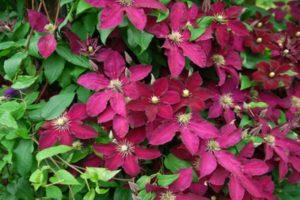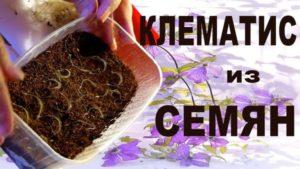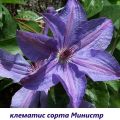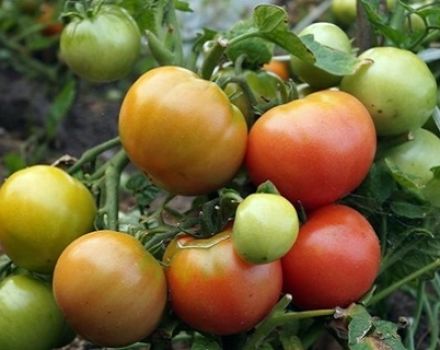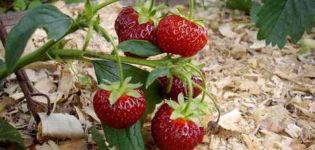Description of Ville de Lyon clematis, cultivation and care technology
Clematis are especially loved by flower growers for their decorative, bright colors of inflorescences. One of the demanded representatives of buttercups, which has successfully taken root in Russian household and summer cottages, is Ville de Lyon clematis. The culture is distinguished by large flowers, long flowering, resistance to fungal diseases.
Description and features
Liana "king" of clematis Ville de Lyon grows up to 4 m. Brown young shoots turn brown with age. The flowers are carmine red, and later purple, they consist of 5-7 petals, fluffy yellow stamens in the center. Reach 16 cm in diameter. Green heart-shaped leaves are much smaller than inflorescences.
The flowering culture begins in July and lasts until the onset of autumn cold weather. Hybrid Ville de Lyon belongs to shrub varieties, produces up to 15 shoots.
From the characteristics of the plant, gardeners distinguish frost resistance, which leads to wintering at the planting site. A perennial bush is immune to fungal spores, is appreciated by flower lovers for being undemanding to watering, giving the site a unique look.
The origin story of Ville de Lyon
In Europe, flower growers have been breeding clematis for five centuries. In Russia, the fashion for large-flowered crops came in the 50s of the last century.
A bright representative of clematis, the Ville de Lyon variety was obtained by the French breeder Morel more than 120 years ago, but it still remains relevant, found in European, Russian, Belarusian and Ukrainian gardens.
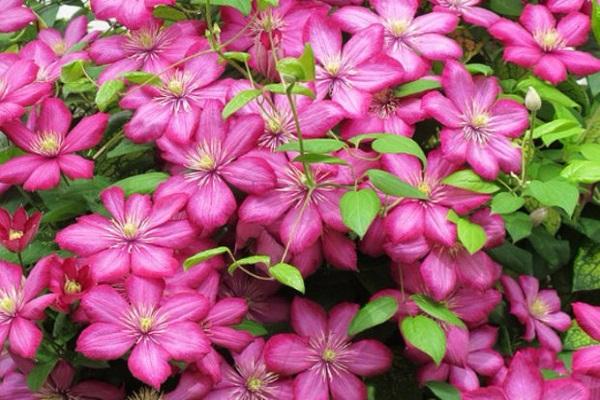
Landing
Before planting, the plants choose a suitable place on the site, prepare the soil, take care of the support on which the vine will curl. For normal vegetation and flowering crops, planting technology is required.
Site requirements
Clematis Ville de Lyon thrives on loose, fertile soils with a neutral acid-base balance. The plant loves morning and evening sunbeams, but intolerant to midday. In the sun, the petals fade, lose brightness.
For the cultivation of clematis, Ville de Lyon, they select a place near the support, protected from gusts of wind that can break the vine. In the southern regions, it is recommended to create a partial shade culture on the ground and the lower part of the bush, planting low plants nearby.
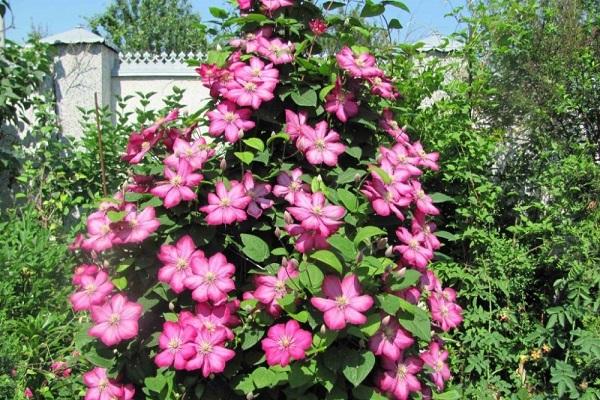
Soil selection and preparation
For planting clematis, choose a slightly alkaline or neutral loam. The increased acidity is neutralized with slaked lime in the proportion of 25-50 kg per one hundred square meters, dolomite flour - 350-500 g per 1 sq. M. m.
The soil is not suitable for the culture, with a predominance of peat and the location of the groundwater source above 1.5 meters from the surface.
The optimal substrate for perennial shrubs consists of four parts of garden soil, compost and one part of sand.
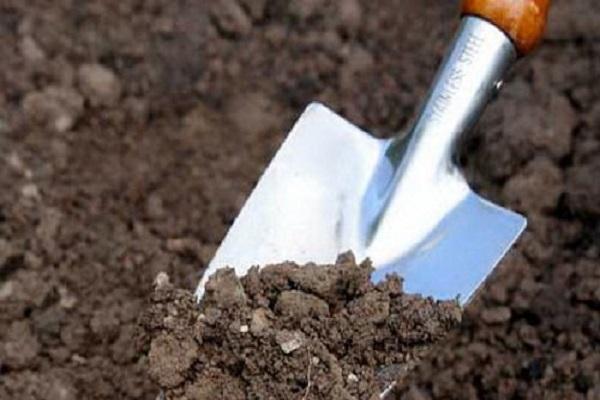
Landing scheme
Clematis Ville de Lyon is planted in April-May before the beginning of the growing season or in the fall after the cessation of the growth of green mass in late September and early October.
For a month, prepare a planting pit in the form of a cube 60 cm deep and 50 cm wide. The fertile layer is mixed with a bucket of compost or humus, add 2 tbsp. l. potassium sulfate, the same amount of superphosphate.
Clematis planting technology:
- an earthen mound is built at the bottom of the pit;
- the seedling is lowered, spreading the roots along the slopes of the elevation;
- deepen the plant so that the growth bud of the lower internode is deepened by 8 cm;
- watered;
- sprinkle the roots with sand mixed with ash, add fertilized prepared substrate on top;
- re-watered.
When planting several plants at the same time, maintain a distance of 80–100 cm between them. They retreat from the wall by 50 cm, make sure that the water flowing down from the roof does not fall on the crop.
If the soil on the site is heavy, and the soil prepared for planting the culture is loose, you cannot additionally make a drainage layer in the pit, since moisture from the entire garden will accumulate in this place.
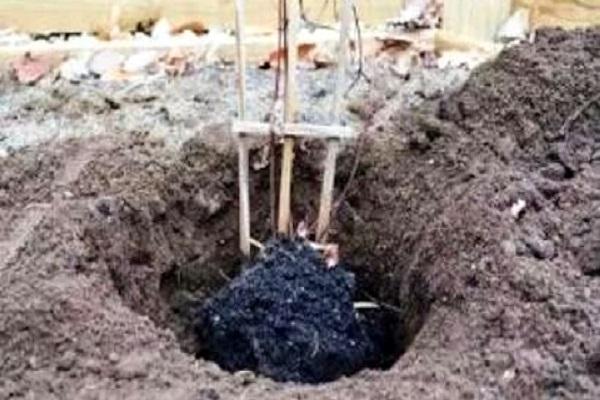
Support
In order not to damage the roots of clematis Ville de Lyon, the support is installed before planting. The device is purchased ready-made or built independently.
Support requirements:
- height from two, width from one and a half meters;
- strength, reliability;
- sustainability;
- fit into the overall design;
- decorativeness.
If trellis for clematis are installed along the facade of the house, then in winter, when the plant is sleeping, they should not spoil the appearance of the building. In addition to trellises, arches are made of PVC pipes. Durable forged metal supports.
One of the less labor-intensive options is digging in two wooden posts, pulling and securing a galvanized chain-link mesh between them. They do it even easier — nails are driven in on the wall of the gazebo and a strong twine is pulled along which the vines will weave.
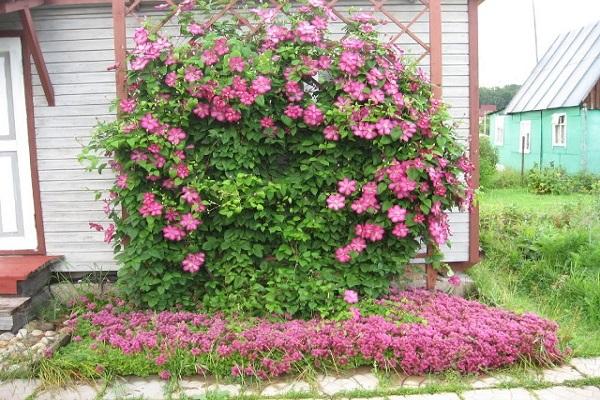
Mulching
To retain heat and moisture, the culture is mulched after planting and in the spring after loosening, removing weeds. In the South, they protect the soil from overheating with a 5-centimeter layer of hay and sand, and in regions with a temperate climate and insufficiently warm summers, vermiculite and humus are used as mulch.
Care rules
Caring for Ville de Lyon clematis includes fertilization during the growing season, irrigation, pruning, protection from pests and diseases. In areas where frosts exceed the temperature mark -20 ° C, the culture requires insulation.
Top dressing
Fertilizers applied during planting are enough for the culture for the first 3 years. Starting from the fourth year, I feed clematis four times per season.
In the spring, at the beginning of the growing season, solutions of mullein or chicken droppings are used for the rapid growth of shoots. After two weeks, use the urea.
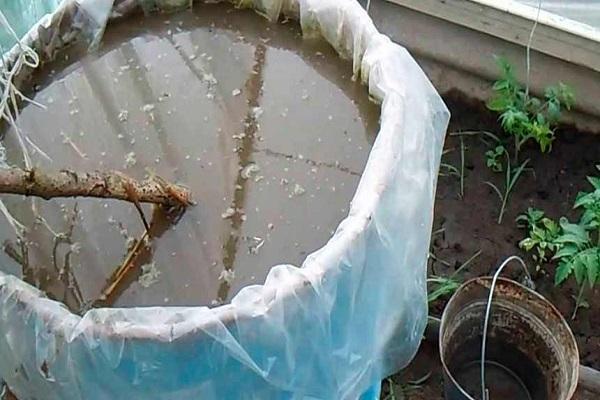
Before the flowering of clematis, complex fertilizers are applied to the soil, including nitrogen, potassium, phosphorus. Nitrophoska is suitable for summer crop feeding.
To increase winter hardiness in the fall, 500 g of ash mixed with humus are poured under each clematis bush.
Watering
Clematis is irrigated once a week. The need for moisture is determined by the level of dryness of the substrate at a depth of 20 cm. In order for the water to reach the roots, buried by 60 cm, they retreat from the base by 30 cm from the bush and dig a small groove into which moisture is delivered.
Another way to efficiently irrigate a crop is to water through the drainage holes of empty flower pots buried in a circle flush with the surface.
Preparing for winter
The stems of clematis Ville de Lyon are cut completely in the fall, so no frames are required. If the winters in the region are mild, it is enough to mulch the soil around the perennial hemp with fallen leaves, hay, humus.
If, in winter, the thermometer drops below the -20 ° C mark, a wooden or plastic box turned upside down is placed above the culture root, and the top is insulated with burlap and spruce branches. To prevent the root from misting, holes are made in the box for ventilation.
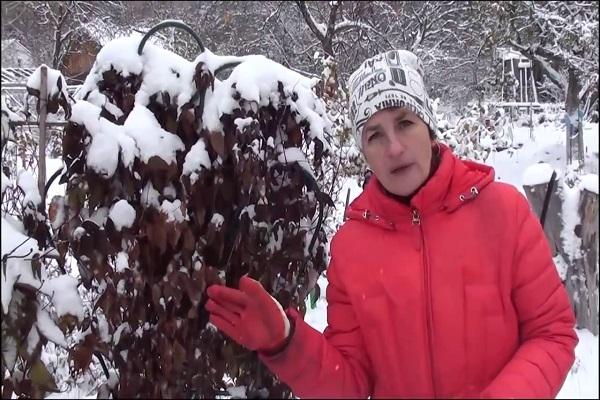
Pruning
Since clematis blooms on the vines of the current year, all the shoots of the bush are removed in the fall. Leave the root part 15 cm high.
In the spring, pruning is carried out to stimulate flowering. The grown stems of the culture are shortened, leaving 7 cm from the upper buds.
Clematis blooms fully in the third year. Therefore, for the first two years during the growing season, it is recommended to remove the formed buds for better development of the root system.
Diseases and pests
Despite the resistance of clematis to viruses and fungal spores, the plant is susceptible to fusarium disease, powdery mildew and wilting. Of the pests, the culture is more often attacked by slugs, aphids, spider mites. Large damage to the plant is caused by butterfly larvae, nematode.
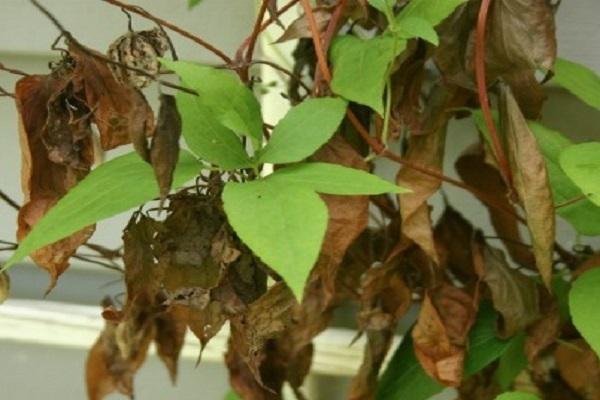
Fusarium
With fusarium wilting, infection of the culture begins from the lower part of the vine. The formed mycelium clogs the conductive channels of clematis, metabolism is disrupted, the leaves dry out on the entire shoot. First, the edges of the leaf plates turn brown, then the fungus captures the entire leaf.
For the development of spores, a stable temperature above + 20 ° C and high humidity are required, so signs of fusarium are visible in the second half of June or July.
To combat the disease, the damaged liana is cut out and removed, the plant is treated with Previkur.
Powdery mildew
A white bloom, similar to scattered flour, covers leaves, flowers, clematis shoots. The organs of the plant rot, die off. The culture stops growing, flowering.
A solution is prepared to treat the Ville de Lyon hybrid. A crushed bar of laundry soap is placed in a bucket of water, 30 g of copper sulfate is added. After removing dead parts, the plant is sprayed with the prepared product.
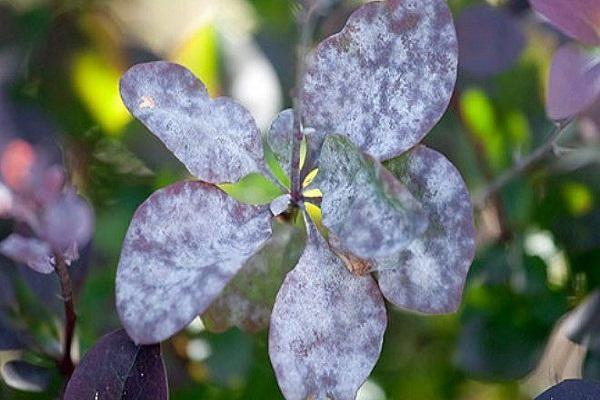
Wilt
Phomopsis wilting of a culture begins with rotting of the root, blocking of the channels for delivering nutrients to other organs in the stem. Small black dots appear on the leaves of clematis, where spores are concentrated. The hidden fungus actively develops and multiplies on the plant during flowering, affecting flowers, vines, foliage.
The disease is contagious and does not respond to treatment. The dead vines are cut out at the root, the remaining ones are treated with foundation. Before planting young bushes, the soil is treated with Trichodermin.
Nematode
Microscopic roundworms 1 mm in size infect clematis Ville de Lyon entirely - roots die off, leaves and flowers shrink.
No effective pest control methods have yet been developed, so the crop is removed and burned. Replacing the land does not give 100% guarantee that young clematis will not suffer the same fate.

Butterflies and moths
The plant is not afraid of the butterflies themselves, but their larvae, which eat green leaves, which subsequently curl up. The harm caused by butterflies and bloodworms inhibits the normal development of clematis.
Helps prevent the invasion of caterpillars by treating the crop with insecticides before the budding period.
Snails and slugs
Pests parasitize on clematis throughout the growing season, eating leaves, buds, inhibiting plant development. Snails, slugs are collected by hand, traps and baits are placed.
To make it harder for mollusks to climb the vine, weeds are regularly weeded.Scattered under the bush means Metaldehyde, ash, lime, superphosphate.
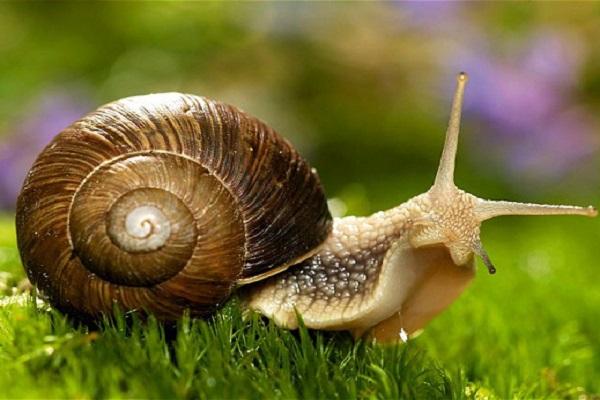
Aphids and spider mites
Due to the small size of aphids and spider mites, their presence on clematis Ville de Lyon is determined by the sticky layer and cobweb on the leaves, respectively.
To scare away insects, culture bushes are sprayed with garlic or wormwood infusion, feverfew, onions, garlic are planted nearby. Of the ready-made preparations, safe Fitoverm is effective, or the fast-acting Actellik, Antiklesch, Akarin.
Reproduction
Clematis is propagated sexually and vegetatively. Planting with seeds does not guarantee that a crop will grow with the varietal properties of the parent plant. More often, gardeners use the vegetative method, which is less labor-intensive and reliable.
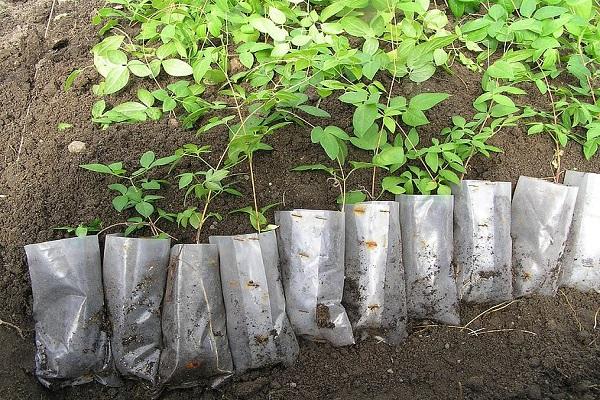
Dividing the bush
Clematis with an overgrown root system is undermined on one side, a part of the root with two or three shoots is separated with a shovel. A young plant is completely removed from the ground before reproduction.
Delenka is immediately planted in a prepared pit.
The method is considered the simplest and fastest, but it is impossible to get many new plants from an adult bush..
Layers
Dig 5 cm grooves for the selected clematis shoots. Vines are laid along the grooves, fixed with metal or wooden brackets, covered with fertile substrate, watered.
During the season, young shoots of Ville de Lyon clematis grow with their roots, which are mulched in autumn. A transplant to a permanent place is done in April-May next year.
The method of reproduction by layering is long, but it gives several plants at once.
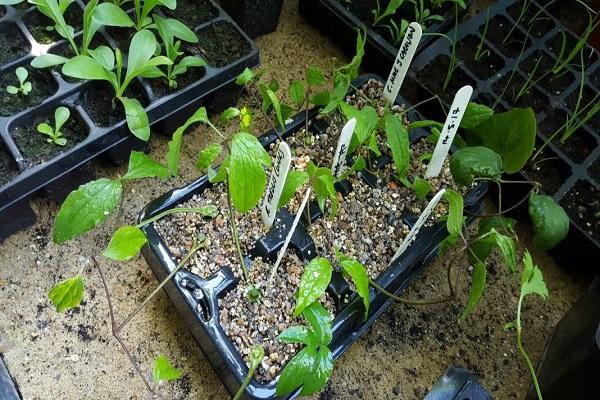
Cuttings
Clematis is propagated by cuttings in June during the budding period. Cut out the middle part of the shoot of a young bush 2-3 years old. Cut segments slightly larger than one internode so that 2 cm remains on top, and 3-4 cm below the internode.
The stalk is placed in Kornevin's solution, planted in a separate glass. The rooting process takes three months.
Seeds
Seeds ripen 90 days after flowering stops. In most Russian regions, climatic conditions impede the formation of full-fledged planting material. In this case, the branch with the fruits is placed in a vessel with water and placed on the windowsill until conditioned seeds are formed.

After collection, the seeds of clematis are placed in a refrigerator for 3 months for stratification. Planted in open ground in spring or autumn. In the latter case, the landing site is mulched. Clematis Ville de Lyon blooms in the third year.
Application in landscape design
Traditionally, homestead and summer cottages are decorated with clematis, curling on pergolas, trellises. Large-flowered plants decorate the facades of houses, gazebos, specially constructed arches. Clematis Ville de Lyon is used as a hedge, letting the crop flow through the netting and planting plants at a distance of 80 cm from each other.
Having picked up several varieties that bloom at different times, you can admire a variety of colors of inflorescences, luscious green foliage from spring to late autumn.
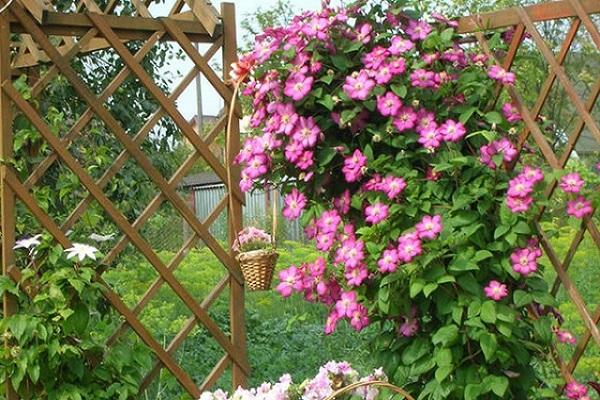
Clematis is used not only as a background plant, but also collect flower arrangements with its participation..
Roses twisting from different sides on arches, pyramids, planted as a hedge, look harmonious next to it.
The culture is combined with grapes, honeysuckle, lemongrass, hydrangea. Old dead tree trunks are camouflaged with clematis. The flowering plant looks favorably against the background of conifers.
Florists more often recognize large-flowered clematis in their plots. Ville de Lyon is one of them, attracting large, small saucer-sized flowers that do not leave anyone indifferent.
